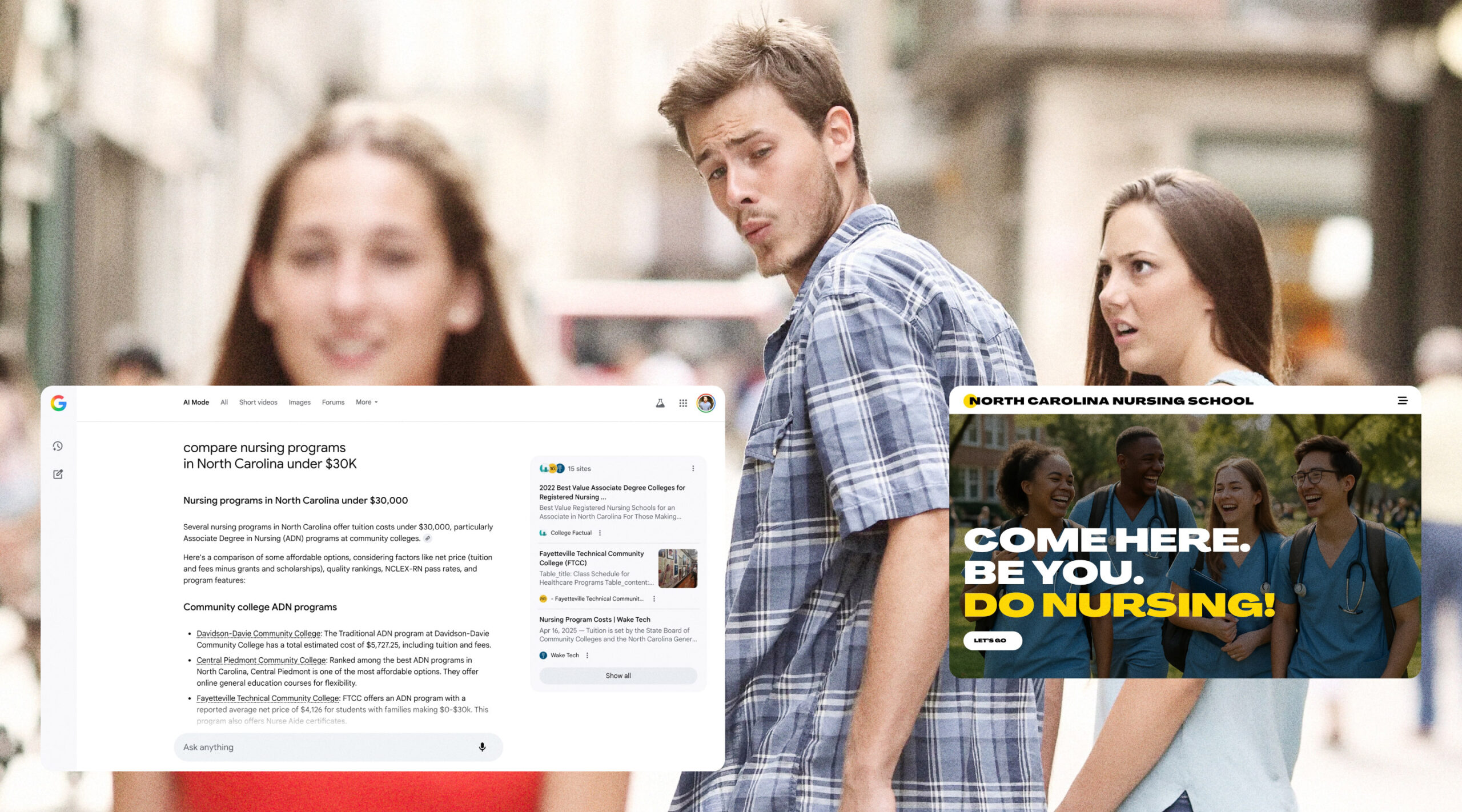For the past several years, the goal of a university’s website has been to provide information about its programs, help prospective students see themselves on campus, and capture enough lead information to follow up with students and encourage them to apply.
A marketer’s job was relatively simple: draw people to your website, get them to fill out a form, nurture them through outbound channels and convince them to apply and enroll. That model works on the assumption that users need to come to your website in order to get the information they need in order to make an informed decision.
That model is being turned on its head. Here’s what you need to know.
The AI Search Boom | How AI Has Changed the Enrollment Funnel | What Your Site Needs to Tell LLMs | How to Prep Your Site Now | Own Your Data, Own Your Narrative | How LLMs Choose Answers
The AI Search Boom
Generative-AI assistants like ChatGPT, Gemini, and Perplexity now answer millions of comparative-shopping questions about majors, tuition, outcomes, and campus vibes before a prospect ever lands on your site.
What surfaces inside those answers isn’t the clever branded headline you spent months crafting or the beautiful images of campus you had professionally shot; it’s structured data: program length, cost, rankings, career outcome stats, and faculty credentials.
But how do you get your institution in that list of results? And if prospective students are gathering this information outside of your owned channels, how should you evolve your strategies for your website and other marketing channels?
The institutions winning that visibility will manage their websites less like a series of pages and more like public-facing APIs that syndicate trustworthy, machine-readable facts anywhere an LLM cares to look.
The strategies and tactics that used to work to surface your brand in search results is changing. But there are things digital marketers can do — right now — to be prepared for this change.
LLM adoption is exploding. More than half of U.S. adults have used a large language model tool in the past year — but teens are the real early adopters. A January 2025 Pew survey found that 26% of U.S. teens already rely on ChatGPT for schoolwork, double 2023 levels. Another youth survey pegged weekly usage closer to 49% for students aged 12-18. They’re comfortable asking AI to “compare nursing programs in North Carolina under $30K,” then skimming the synthesized answer rather than clicking ten blue links or navigating ad-covered pages on third-party sites.
Add Google’s new AI Mode (the evolution of AI Overviews) rolling out across U.S. search results, and suddenly the top of the funnel is occupied by chatbots and featured snippets rather than your beautifully designed landing page. Early results show those summaries end with a thud of zero-click searches and potentially massive traffic drops for websites.
Either way, the real estate you control is shrinking.
How AI Has Changed Your Enrollment Funnel
Traditionally we drew a neat line from the awareness phase to consideration and decision phases:
Ad Campaign → Web visitor → RFI Submission → Nurture Emails → Applicant → Enrolled Student
As students shift their search for information onto so-called “neutral” third-party platforms, your public web experience shifts from being a top-of-funnel tool for discovery to a bottom-funnel place to confirm what they’ve heard and test the vibes on if they can see themselves on campus IRL.
So while AI does the heavy lifting of awareness and comparison, your website content will need to evolve to support students’ questions about confirming their fit, evaluating campus culture, and complete transactions.
AI is stress-testing every stage:
| Funnel Stage | Old Reality | New Reality |
|---|---|---|
| Discovery | Google search, rankings pages, counselor recs | ChatGPT / Gemini comparisons, TikTok reviews & peer Discord groups |
| Consideration | Program pages, virtual tours, cost calculators | Summarized pros/cons in AI overviews, Alumni testimonials cited by bots |
| Intent | RFI form, campus visit registration | “Ask-the-chatbot” widgets pulling from your course catalog API |
| Decision | Application CTA, counselor follow-up | Instant-answer agents, scholarships auto-matched via API, .edu website |
| Yield/Vibe Check | Visit day, admitted-student portal | Social proof on Reddit, YouTube, Instagram Live Q&As |
What Your EDU Website Will Need to Deliver Info To LLMs
To have LLMs be able to parse your site and deliver your school information to inquiring students, there are four things to start thinking about:
- Structured data everywhere. Courses, tuition, dates, learning outcomes, faculty bios, accreditation should be clearly available on-page, but also implemented using JSON-LD, Schema.org, OpenAPI, or GraphQL so machines can consume it without screen-scraping.
- Composable micro-services. Instead of creating monolithic pages of HTML body copy, create discrete web services for key information: program directory, cost calculator, event feed. Each delivers clean endpoints that marketing tools, chatbots, and third-party apps (Slate, Element451, TikTok lead forms) can digest.
- Real-time updates. Tuition change? New program launching? Update once in the “truth layer” (more on that below), and every channel — site, chatbot, ranking table — refreshes instantly.
- Authentication layer for sensitive actions. Applications, payments, transcript requests still route through secure UI flows, but even those can expose progress data back to advisors via APIs.
How to Start Preparing Your Site Now
Upgrade your schema markup.
Begin with School, Program, Course, Event, and FAQ schemas. Validate in Google’s Structured Data Testing Tool and monitor impressions in Search Console. Bonus: many AI crawlers prefer JSON-LD because it’s lightweight.
Build your “truth-layer” API.
Expose key objects — program pages, scholarships, application deadlines — via REST or GraphQL. Most CMSs (WordPress, Drupal 10) can provide a flexible REST API that can allow you to expose various content types like posts, custom post types, and taxonomies through API endpoints.
Map your audience’s off-site hangouts.
Learn where your target audience is spending time and searching for relevant information. Tools like Sparktoro provide audience research about where your audience lives, what they watch, and who they follow. Fill in the gaps with user interviews and surveys. If your prospects are asking Discord and TikTok influencers for advice, you need partnerships there. Authentic collabs with these groups will beat display ads.
Double-down on earned authority.
Pitch faculty research to niche journals, secure guest spots on relevant podcasts, and provide quotable data sets. Those citations feed LLM training loops and raise your “confidence score” in AI answers.
Refresh your brand narrative.
In a world of AI curation, differentiation isn’t what you offer (everyone has an MBA) but why it exists, who it serves, and how it feels. Workshop a one-sentence story that admissions, web, social, and chatbots can repeat verbatim.
Pilot an AI-compatible chatbot on-site.
Use your new API to power an admissions assistant that answers tuition, deadlines, and program-fit questions 24/7. Measure reduction in basic email inquiries and uplift in qualified applications.
Write in LLM-Friendly Copy & Formats
Combine human-sounding answers with LLM-readable formats. For instance, FAQ blocks, short bullet lists, and simple tables are easy for LLMs to lift your facts verbatim. Give every image descriptive alt-text, link to authoritative sources (.gov data, peer-reviewed studies), and strip any fluffy marketing adjectives that don’t add information. This mix can boost the confidence score that LLMs use to decide whether to quote your school in their answers.
The Takeaway: Own Your Data, Own Your Narrative
This might all sound a little scary. But to be clear, despite all the hand-wringing over the death of search, I’m not arguing that you should abandon your SEO efforts. By 2026, AI assistants could command a full percentage point of global “search” share — tiny compared to Google’s 89%, but already big enough to redirect millions of potential students’ eyeballs. Schools that treat their websites as flexible data services will control how, where, and in what context their brand shows up — whether it’s a Gemini snapshot, a Slackbot reply, or the next-gen campus app.
Need Help Turning Your Website Into A Data Distribution System?
Contact our team to audit your current data structure, roadmap a schema and endpoint strategy, and pilot the tactics above. The sooner your information is LLM-readable, the sooner tomorrow’s applicants will be able to find — and trust — you.
Background Info: How LLMs Choose Their Answers
With the explosion of AI search, the obvious next question for marketers is “How do I get these LLMs to recommend my brand?” It’s important to realize that large-language models don’t “rank” pages the way classic SEO algorithms do. Instead, most modern systems follow a retrieve-then-generate process that looks like this:
- Query understanding. The model translates the user’s question into various parameters that infer intent, context, and nuance (e.g., “Compare affordable online nursing programs” vs “top-ranked nursing programs in NC for first-gen students”).
- Retrieval of possible answers. The LLM then searches web pages, databases, and even live news feeds that might match your prompt and its intent to analyze the top several hundred snippets.
- Scoring the results for authority and freshness. Each potential answer is then weighted for source credibility (academic domains, government data, high-authority media), recency, alignment with the query, and, most importantly, how often that source has been cited or corroborated elsewhere. Schema markup and clean APIs help here because they reduce ambiguity and boost confidence.
- Personalization filter. Before creating its final response, a user-context layer personalizes the ranking based on what it knows about you. Factors can include language settings, your location, prior conversation history, and implicit preferences (“You’ve asked about community-college transfers twice already”). For users that have a logged-in profile with a platform like ChatGPT or Google Gemini, these signals grow stronger over time.
- Create an answer with citations. The model then picks the highest-scoring pieces, assembles a narrative, and (ideally) attaches inline citations.
With this process, if your structured program data is authoritative, machine-readable, and corroborated by third-party mentions, it’s far likelier to surface—and to be assembled in ways that feel personally relevant to each prospect.



